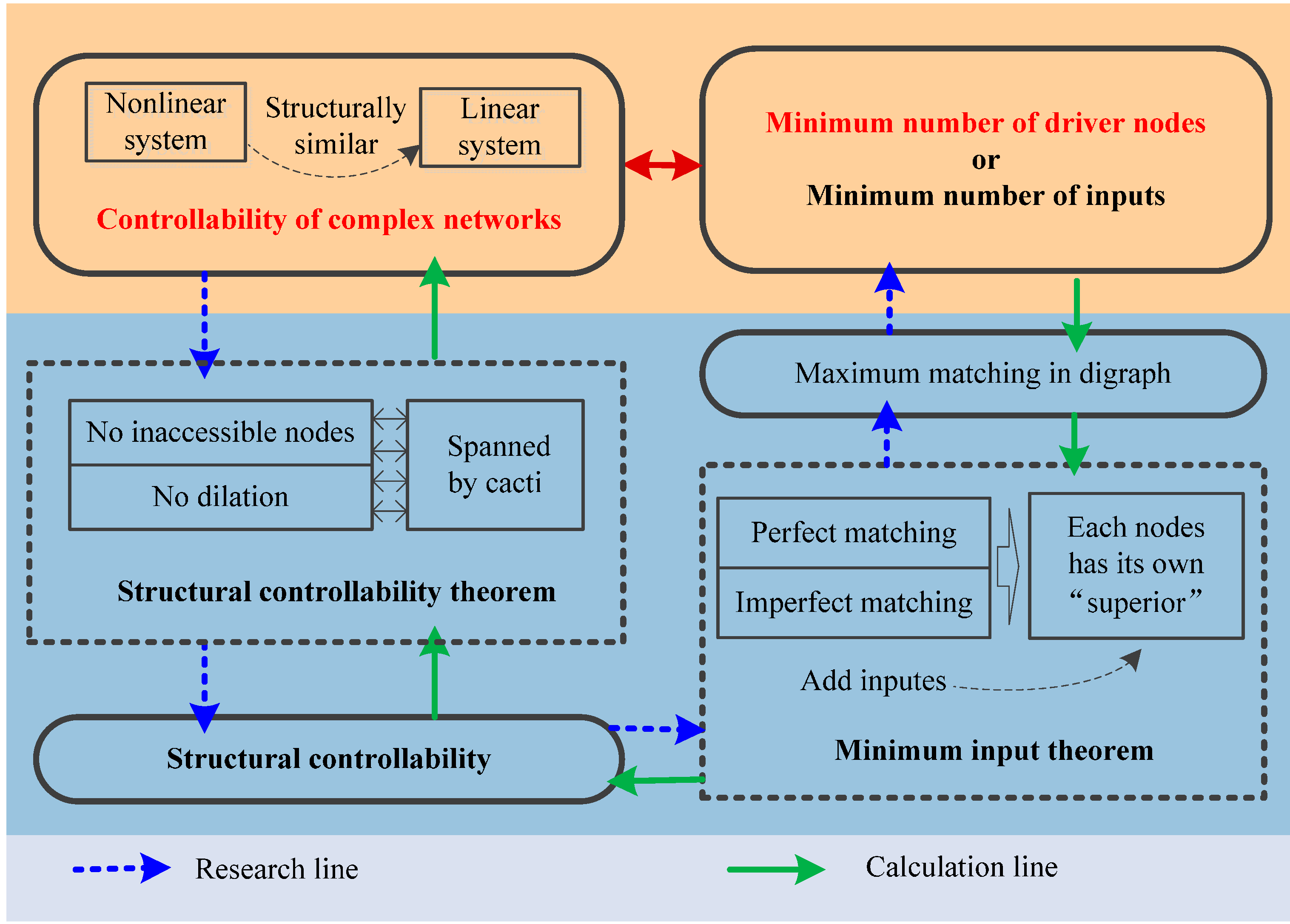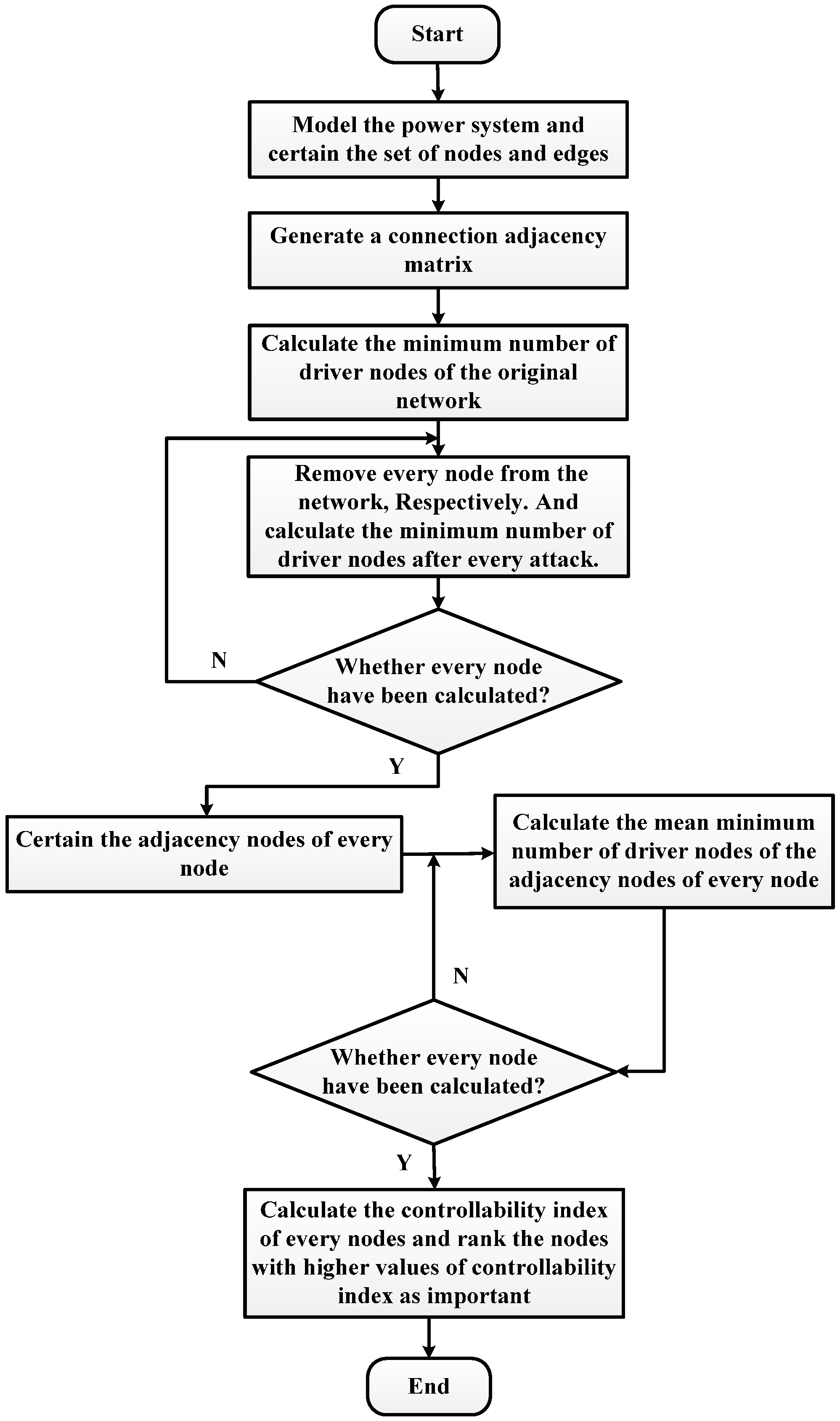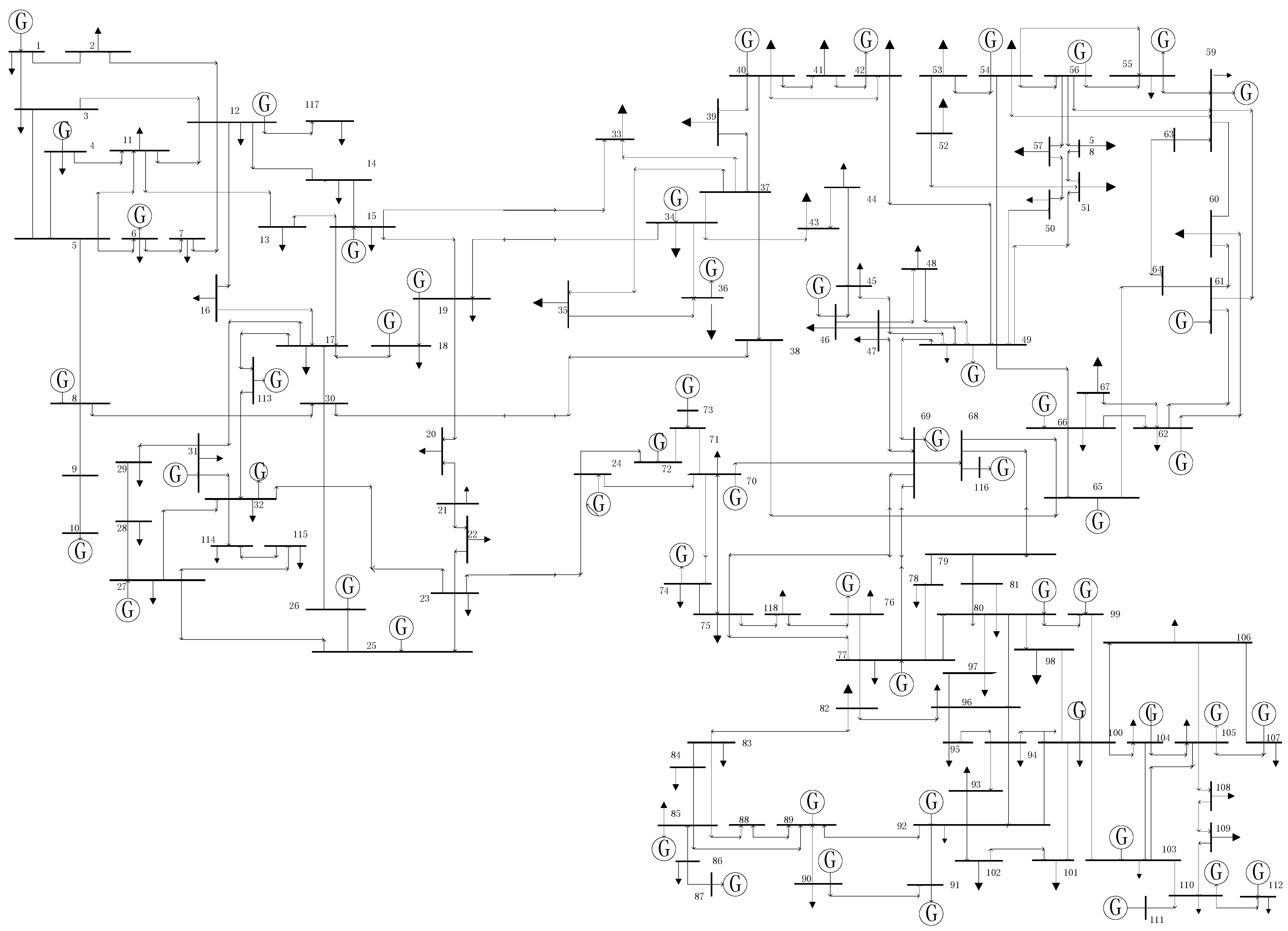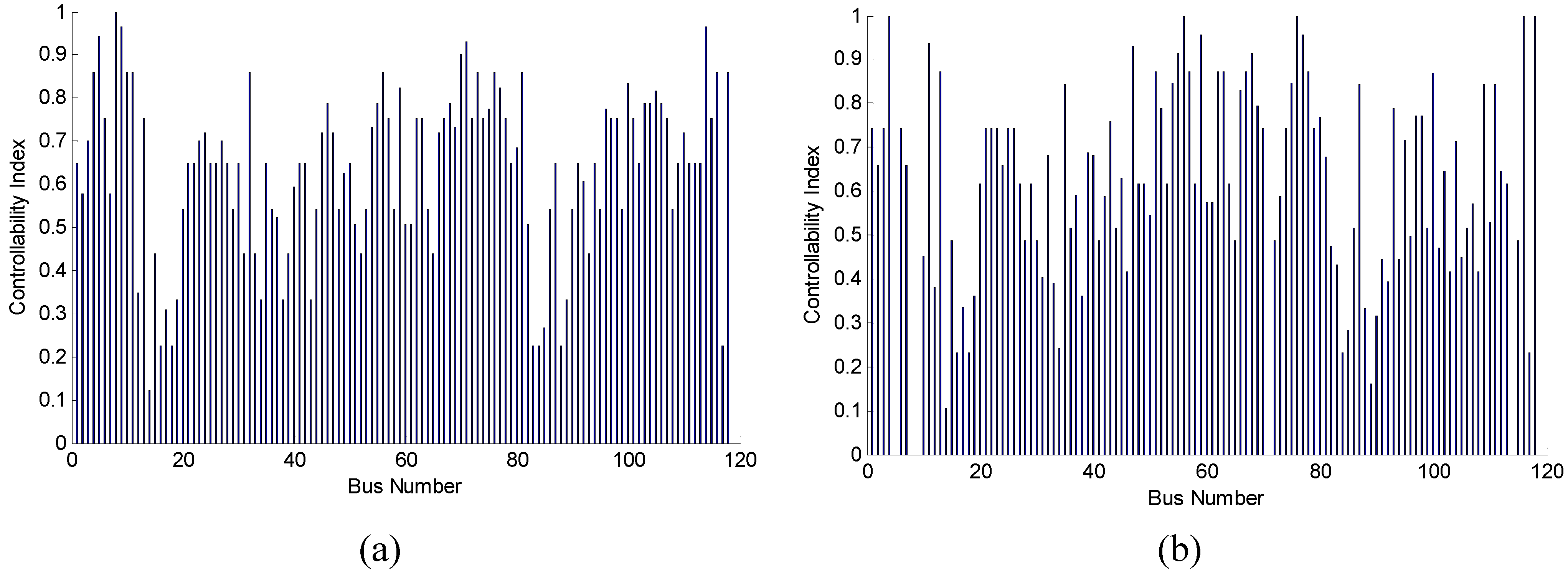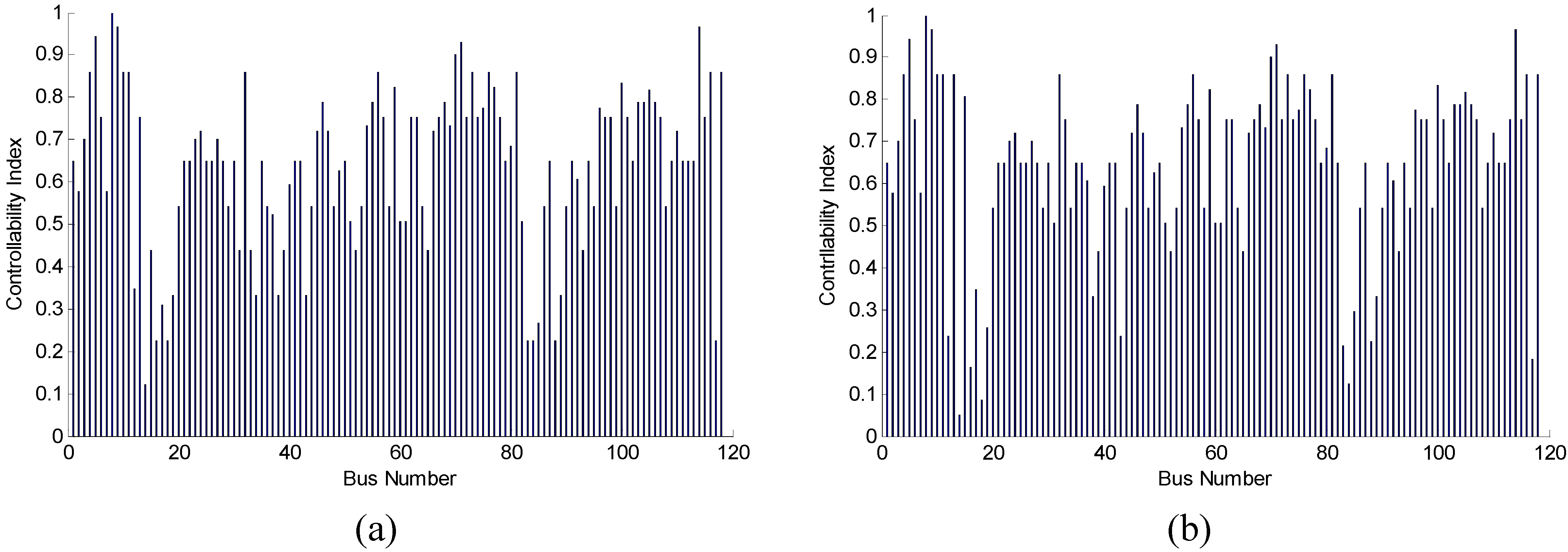1. Introduction
Over the last decades, a number of power system blackouts caused by natural disasters or human factors have occurred, which led to a series of serious effects on the functionality and reliability of the networks, economic growth, and social stability [
1,
2]. The failure of a few critical nodes or lines can make the system very vulnerable to attacks, which may be the major reason causing the blackouts [
3,
4,
5,
6]. Thus, it is very important to identify the critical nodes and lines so that the system reliability and efficiency can be improved by monitoring and protecting them. In the past decades, studying the vulnerability of power systems has been a hot issue and many worthy results have been obtained [
3]. Most of them assess the vulnerability of the power system by studying the system stability including transient [
7], voltage [
8,
9], and frequency [
10] stability,
etc.
It is well recognized that the complex network theory is very suitable to solve large-scale practical problems. Based on the graph theory, the subject system can be studied from the point of view of structure and dynamical functions of an array of nodes and lines, in which the degree of dependence on the dimensionality of the system can be obviously reduced. Recent developments in this field have opened up a new way to power system research. In recent years, there has been an increasing interest in the study of assessing the vulnerability of the power system based on the complex network theory [
3,
11,
12,
13,
14,
15,
16,
17,
18]. For example, [
13] analyzed the structural vulnerability of the North American power grid and concluded that the nodes with high degree play an important role in power systems. Considering the influence of physical topological structure, the concept of betweenness is proposed to identify important nodes or lines in [
14,
15,
16,
17]. Additionally, a novel betweenness index was defined in [
11], in which the reactance was defined as the weight of the lines. However, it is not necessary that the power only flows through the shortest path in a power system. Then, the idea of using the maximum flow theory to analyze the vulnerability of power systems was first proposed in [
18]. Yu
et al. have defined a centrality index to identify the critical lines in power systems with improved results in [
3], which considered the maximum flow from the generator nodes to the load nodes based on the Ford-Fulkerson theorem. It should be noted that, although lots of worthy results have been obtained, there still exist some problems that were not well handled. Firstly, few of the existing literatures take the system’s controllability into account. However, if the power systems cannot offer full control over the networks, when several important nodes are in fault, some serious phenomenon may occur, e.g., the phenomenon of voltage collapse, which has been well discussed in [
19,
20]. Secondly, in order to calculate the indexes such as the betweenness index [
17] and the centrality index [
3], weight of each link (transmission line) needs to be known. However, for most real networks, the weight of each link is either unknown or known only approximately and time-dependently. These problems are the main motivation of our study.
Network controllability is a vast area of research with a long history [
21,
22,
23,
24,
25,
26,
27,
28]. The structural controllability was first presented and studied in [
26], which proved that a physical system is controllable if the system is structurally controllable. Furthermore, in [
29], Liu
et al. extended the results in [
26] and proposed a network controllability model to solve the computable problems of the network controllability. It concluded that the minimum number of driver nodes can be calculated by the maximum matching method which was introduced in [
30], and the structural controllability problem can be translated into an equivalent geometrical problem. Therefore, according the aforementioned discussions, this paper proposed a novel method for assessing the vulnerability of a power system based on structural controllability and the network controllability model. The main contributions of the paper are as follows:
(1) Based on network controllability theories, a novel controllability index is established for assessing the vulnerability of power systems, which can effectively identify the critical nodes from the perspective of network controllability.
(2) In order to maintain full control of the power systems, the network controllability model is used to calculate the minimum number of driver nodes for solving this problem.
(3) The proposed method can overcome the limitation of the hypothesis that the weight of each link or transmission line must be known.
Meanwhile, the simulation results show good performances in identifying the critical nodes in the IEEE 118 and 300 bus systems. Furthermore, the effectiveness is validated.
This paper is organized as follows. In
Section 1, the background and fundamentals of the research are discussed. In
Section 2, some necessary controllability theories of complex networks are briefly introduced, and a directed power system is defined. In
Section 3, the controllability index that used to identify the critical nodes is defined and the identification process is listed. In
Section 4, the proposed methodology is applied to identify critical nodes on the IEEE118 and 300 bus systems. Additionally, it also discusses the performances of the system under random and targeted attacks. Lastly, we conclude the paper in
Section 5.
2. Modeling Power Network Based on Controllability Theories of Complex Networks
In the following, the necessary concepts of the controllability of complex networks theory are presented. Then, the framework to solve the controllability of complex networks will be given. Finally, the network controllability theories will be appropriate for the power system and a directed power system will be defined based on the controllability theories of complex networks.
2.1. Basic Knowledge
(1) Structural Controllability: Lin’s structural controllability theorem has been verified in [
26], which indicated that a linear control system is structurally controllable if there are no inaccessible nodes and no dilation, or the system is spanned by cacti. What we focus on is that a physical system can be regarded as controllable if it has structural controllability [
26,
29]. In other words, the link weights are 1 or other non-zero values that do not affect the structural controllability of the system. Thus, structural controllability can overcome the disadvantage of incomplete weight information.
(2) Calculation of Driver Nodes: According to the minimum input theorem, the structural controllability problem can be translated into the maximum matching in its corresponding digraph. Let
N1 and
ND denote the minimum number of inputs and the minimum number of driver nodes, respectively.
M* is the number of matched nodes, and
N is the total number of nodes. Then the minimum input theorem can be mathematically represented as follows [
29]:
Moreover, the framework to solve the controllability of complex networks is shown in
Figure 1. An uncontrollable system can be converted to controllability through adding inputs to the minimum number of driver nodes.
Figure 1.
Framework to solve controllability.
Figure 1.
Framework to solve controllability.
2.2. Modeling Power System
According to graph theories, a network is composed with a set of nodes and edges. There are two types of networks containing undirected or directed networks. A network is defined as a directed network if all the connection edges are directed; otherwise, it is undirected. For any directed networks, the information, signal or energy can be transferred from one node to another node via the edges through the network. As far as power systems are connected, the edge weights are usually defined as the reactance so that the shortest path can be translated into the shortest electrical distance, and some other research also used the admittance, which is proportional to the amount of power flowing through any line of the transmission network. However, for most real networks, the weight of each link is either unknown or is known only approximately and time-dependently. According to structural controllability, a system is structurally controllable if it is possible to choose the non-zero weights. Thus, structural controllability supplies a method to overcome inherently incomplete weight information. If a system satisfies Lin’s structural controllability theorem, the weights are 1 or non-zero values which do not affect the structural controllability of the system. Thus, in this paper, if there is a directed connection form node i to node j, then the value of eji is 1, which means the controllability of node i can be affected by node j.
A power system can be seen as a large complex network with a set of nodes and edges. Thus, the controllability just discussed can be appropriate for the power system. For any power system, the generators, loads, and bus bars are modeled as the nodes, and the connecting transmission lines are modeled as the lines or edges. Based on the power flow in the network, the power system should be modeled as a directed network. Furthermore, according to the Kirchhoff laws, the node-voltage method is a good way to analyze a large power system and is used to calculate the current through the power system. The direction of the power flow can be seen as fixed in any steady state [
3]. Therefore, suppose
G = (
V,
E) is a power system with
n nodes and
k lines where
V is the set of nodes and
E is the adjacency matrix which define the connectivity of the network. If there is a power flow from node
i to node
j, the value of
eji is 1; otherwise,
eji will be 0. Then, the obtained adjacency matrix can be used to calculate the controllability of the network.
4. Simulation Study
In this section, several simulations under different scenarios have been studied to verify the effectiveness of the proposed method, in which the maximum matching and the identification algorithm are programmed through the M-function. The first case is used to show the identification results using the proposed controllability index without any fault or attack. The second and the third cases show the performance of the test system under targeted attacks and random attacks, respectively. In the first three cases, the IEEE 118 bus system as the test system is shown in
Figure 3. Then, the proposed method is applied to a larger IEEE 300 bus system to further verify its effectiveness. In the last case, the comparison between the proposed method and some conventional method will be studied. In addition, all the simulation studies are under steady-state conditions.
In practice, there are many types of problems that can lead the power systems to be in fault (e.g., under-voltage, overload,
etc.). However, in the theory framework of a complex network, when a fault happens to a node, it can be equivalently seen as an invalid node, meaning the node is disconnected from the network [
3]. Therefore, in this paper, the nodes will be disconnected from the network if they are in any kind of fault. In addition, all faults in this paper can be considered as a result of the targeted attacks and random attacks, which are two typical types of attack in power systems. The targeted attacks mean that the few critical nodes with higher controllability index values are attacked to failure. On the contrary, random attacks mean that any of the less important nodes with low controllability index values are attacked to failure. During the simulations, a node will be in fault and disconnected from the network if it is subjected to targeted attacks or random attacks.
4.1. Case Study 1: Without Attacks
In this case study, the IEEE 118 bus system is modeled as a directed graph using the earlier methodology. Then, the proposed method is applied to identify the critical nodes in the IEEE 118 bus system. The nodes are ranked based on their controllability indexes and the nodes are regarded as critical if they have higher values of the controllability index. The normalized controllability indexes of critical nodes of the IEEE 118 bus system are plotted in
Figure 4. The results are averaged over 100 realizations. In terms of the controllability index, it can be clearly see that some nodes are given higher ranking in this analysis, and they are considered of criticality. From the point of view of controllability, those nodes with higher values of indexes play an important role in maintaining full control of the system. If they are in faults, the whole power system may not be controllable or may need more external inputs to maintain the controllability. Furthermore, the robustness of the network will be test in case study 2 and 3.
Figure 3.
IEEE 118-bus Test system.
Figure 3.
IEEE 118-bus Test system.
Figure 4.
Normalized controllability index.
Figure 4.
Normalized controllability index.
4.2. Case Study 2: Under Targeted Attacks
In this case study, the focus is on the performance of the proposed method under targeted attacks so that the reliability of the results in case study 1 can be verified. In order to test the robustness of the power system, the analyzed network is subjected to targeted attacks. The set of nodes considered to be critical is disconnected one by one, and the minimum number of driver nodes of the remaining network is calculated after every attack. The results are averaged over 100 realizations and the mean values are plotted in
Figure 5. After five such attacks, it can be clearly seen that the minimum number of driver nodes obviously increases as the number of attacks increases, and there needs to be an increase of approximately nine driver nodes to maintain full control of the network, which means that the control robustness of the network is very poor under targeted attacks. Additionally, it shows that the few critical nodes can make the system very vulnerable to attacks in practice. Furthermore, the controllability indexes of the remaining nodes of the IEEE 118 bus system are recalculated after such five targeted attacks. The identification results before and after five targeted attacks are plotted in
Figure 6a,b, respectively. It can be observed from
Figure 6b that the controllability index distribution is changed clearly, which means there has been a significant driver nodes shift among nodes. In other words, the input should be redesigned so that the analyzed network can be fully controlled. However, it is very difficult or impossible to do that in practice. If the network cannot adjust, it may not offer full control over the network and cannot limit the power system into permitted range. Then, further failures will happen.
Figure 5.
Increase in ND of the network after attacks.
Figure 5.
Increase in ND of the network after attacks.
Figure 6.
Effect of targeted attacks on controllability index distribution. (a) Original distribution; (b) Distribution after five targeted attacks.
Figure 6.
Effect of targeted attacks on controllability index distribution. (a) Original distribution; (b) Distribution after five targeted attacks.
4.3. Case Study 3: Under Random Attacks
In this case study, the focus is on the performance of the proposed method under random attacks compared with the results under targeted attacks. The initial conditions are the same as in case study 2. Then, the analyzed network is subjected to random attacks. The nodes with low controllability indexes are disconnected randomly, and the minimum number of driver nodes of the remaining network is also calculated after every attack. The results are averaged over 100 realizations and the mean values are also plotted in
Figure 5. It is shown that the minimum number of driver nodes is not clearly changed after five such attacks, which means that the network is very robust in response to random attacks, and the failure of those nodes may not obviously affect the controllability of the system. Furthermore, the identification results before and after five random attacks are plotted in
Figure 7a,b. The results show that the controllability index distribution before and after random attacks is very similar, which means the driver nodes distribution is almost not changed. Roughly speaking, the nodes with higher controllability indexes before attacks still have higher ranking in this analysis.
Figure 7.
Effect of random attacks on controllability index distribution. (a) Original distribution; (b) Distribution after five random attacks.
Figure 7.
Effect of random attacks on controllability index distribution. (a) Original distribution; (b) Distribution after five random attacks.
4.4. Case Study 4: Implementation on the Tibet Power Grid
In this case study, the IEEE 300 bus system is further considered to show the effectiveness of the proposed critical nodes identification method for a larger power system. The simulation method and process are the same as in case studies 1 to 3, and the simulation results are shown in
Figure 8.
Figure 8a shows the initial identification results, where some nodes also carriers of higher controllability indexes, which are consider of criticality.
Figure 8b shows the minimum number of driver nodes of the remaining network after every targeted and random attack. It can be seen that there needs to be an increase of approximately 12 driver nodes to maintain full control of the network after five targeted attacks. The increased numbers are more than the corresponding results in the IEEE 118 bus system, which means the larger the size of the system, the more difficult it is to maintain full control of the system when the small numbers of critical nodes are absent. Thus, it is more important to identify the critical nodes as the system increases. In addition, there needs to be an increase of approximately 23 driver nodes to maintain full control of the system after 10 targeted attacks. On the contrary, the minimum number of driver nodes is not changed clearly after 10 random attacks.
Figure 8c shows the controllability index distribution after 10 targeted attacks, and the identification results are changed clearly compared with the results in
Figure 8a. However, the identification results are very similar before and after 10 random attacks, as shown in
Figure 8a,d. Therefore, the simulation results mentioned above have once again proven that the system is very robust to random attacks but not targeted attacks, which further verifies the effectiveness of the proposed method.
Figure 8.
Identification results of the IEEE 300 bus system. (a) Initial controllability index distribution; (b) Increase in ND of the network after arracks; (c) Controllability index distribution after ten targeted attacks. (d) Controllability index distribution after ten random attacks.
Figure 8.
Identification results of the IEEE 300 bus system. (a) Initial controllability index distribution; (b) Increase in ND of the network after arracks; (c) Controllability index distribution after ten targeted attacks. (d) Controllability index distribution after ten random attacks.
4.5. Case Study 5: Comparison with the Conventional Method
In this case study, we focus on analyzing the differences between the proposed method and some conventional methods. It has been previously mentioned that the main vulnerability analysis methods of power systems can be classified as the methods based on system stability and the ones based on complex network theory. The methods based on system stability (e.g., modal analysis based on the Jacobian matrix of the power flow equations, which aims at defining the sensitivity coefficient to assess the stability of the power system and uses the values of sensitivity indexes to identify the critical nodes or bus [
8,
9]) contain a mass of complex operations which make their analysis a very time-consuming and computation-intensive task. Therefore, it is not very suitable for the vulnerability analysis of large-scale power systems. As an alternative, the methods based on complex network theory have been proposed to assess the vulnerability of power systems in recent decades, which take both the electrical parameters and the topological characteristics of power systems into account in their analysis [
18]. This method originated from graph theory and studies the subject systems from the point of view of structure and dynamic function of an array of nodes and lines without heavily relying on the system dimensionality [
3], which makes it very suitable for the analysis of large-scale systems. However, as discussed above, most of the existing literature on this issue [
3] and [
11,
12,
13,
14,
15,
16,
17,
18] rigorously requires that the weight of each link must be known and does not consider the system’s controllability, which seriously limits its applications in real systems. Compared with the conventional methods mentioned above, the method in this paper presented a new way to analyze the vulnerability of power systems by considering the system structure controllability, which is suitable to assessing the vulnerability of large-scale power systems as it does not contain complex operations. Moreover, it only requires knowing if there is a direct connection between any two nodes but does not require knowing its accurate connection weight, which can overcome inherently incomplete weight information in real systems.
